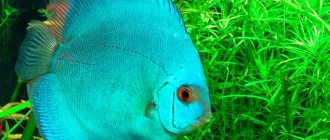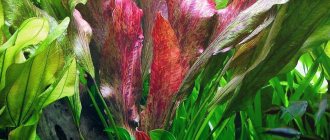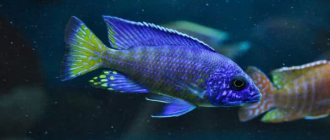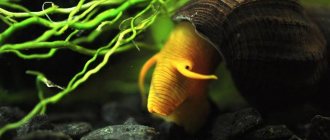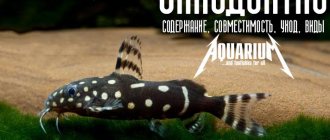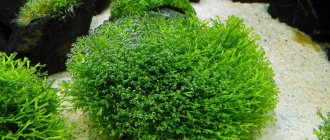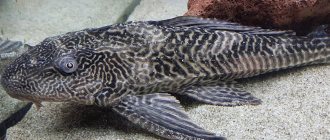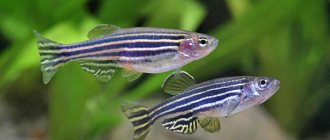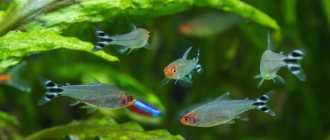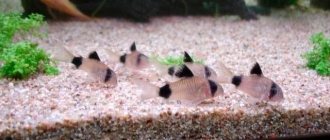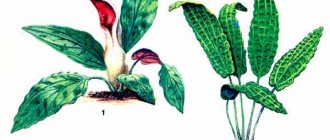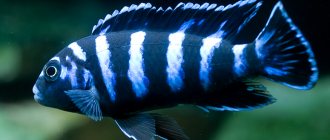Snakehead is not an ordinary fish. The name alone is worth it: it seems that something like a dragon is swimming in the rivers of its range. With a rich imagination, some people may actually see a snake’s head in the guise of this fish. However, not everyone has such an imagination. If we use figurative associations, then a snakehead is rather something between an eel and a pike.
Snakehead is not an ordinary fish
Where does it live?
Snakeheads, or snakeheads, are freshwater predators; they are found in lakes, rivers, ponds, and other freshwater areas. Fish prefer to be in thickets at shallow depths. They are also not afraid to settle in waters with low oxygen content, as they can absorb it from the air. For this reason, they often swim to the very surface of the water, otherwise a lack of oxygen can threaten death.
According to one version, the snakehead previously lived in Indian reservoirs.
Today it is increasingly found in the waters of rivers in the Far East - from the Yangtze River to the Amur itself. In Russia, its main habitat is the Primorsky Territory: the Ussuri, Khasan, Razdolnaya and Khanka rivers. These river reservoirs have the most favorable conditions for creating fish offspring.
At the end of the 20th century in central Russia, biologists began to breed snakeheads. The individuals, at the age of one year, were brought to the waters of the Moscow Zoo. From the Syrdarya River, which was replenished with them, these fish spread to the neighboring republic, Kazakhstan and Uzbekistan.
Snakeheads are artificially bred in ponds in the Moscow region. But to catch them in their natural habitat, fishermen go to the Far East. A popular species is the Amur snakehead.
They are also found in Asia, the USA, Indonesia, Africa and China.
Yandex.Pictures
Spreading
Under natural conditions, the brown snakehead is common in the waters of Vietnam, India, China, Korea, Laos, Indonesia, Malaysia and Thailand. As an invasive species, it is found in water bodies of North America. This species is usually found in rice fields and marshy ponds, preferring to stay in shallow water and heavily overgrown areas. Fish breathe atmospheric air and are able to endure drought for quite a long time by burying themselves in silt. The snakehead's body secretes mucus abundantly, covering the body and protecting the skin from drying out. The snakehead is equipped with special epibranchial respiratory organs that allow it to breathe atmospheric air. Without free access to air, fish can die even in fresh water. If the reservoir dries up, the snakehead hides in a special chamber dug in the silt, lubricated with mucus, and remains there until the next rainy season begins. Snakeheads, like some labyrinths, in natural conditions often crawl from pond to pond in search of food and new habitat.
Description
The snakehead comes from the freshwater family of the same name. There are three genera, one of which is already extinct, and more than 30 varieties.
In appearance, these fish are similar to reptiles, they also show aggression, have an elongated body and a toothy mouth. They belong to the order of predatory fish. Their maximum length is up to 1.5 meters and their average weight is 7 kg (30 kg were encountered several times).
The body structure is elongated and muscular. The head has a flattened shape from below and above, eyes bulging on the sides, a large wide mouth, a small rounded tail, a long dorsal fin from the head to the tail - this is what a snakehead looks like.
Its ability to breathe air allows it to survive even when the reservoir dries out, but for no more than five days. And the slippery cylindrical body, reminiscent of a snake in its structure, helps to move to a neighboring body of water during drought.
The snakehead breathes air thanks to the presence of the epibranchial organ and air sacs in which oxygen accumulates.
Yandex.Pictures
Features of the body
Snakehead is a fish that can breathe air using its lungs.
They are located directly in the epibranchial region and are responsible for saturating the body with oxygen. In addition, he has several air sacs located directly under the skull. Throughout the day, oxygen accumulates in them, which is distributed through blood vessels throughout the body. Today, science knows about 29 species of snakeheads, the most dangerous of which is the giant snakehead called Channa micropeltes. This is the largest species of this predator. If it appears in a small body of water, it can cause significant problems for its inhabitants. It easily adapts to new conditions and begins to reproduce quite quickly.
As soon as the snakehead destroys all the inhabitants, it will simply crawl into another body of water.
Another feature of this predatory fish is its addiction to the taste of blood, which only intensifies its hunger. When attacking a prey, the snakehead tries to swallow it completely. Moreover, the role of food can be played not only by fish, but even by their own smaller relatives. Therefore, it is not surprising that snakeheads fearlessly attack even people and animals.
What do they use to catch
For many, fishing for snakehead is an exciting activity, more reminiscent of hunting. Since it is one of the most delicious freshwater fish and can reach gigantic sizes, fishermen have a competitive interest in it. During this process, they literally feel like snake catchers, because the fish has a significant external resemblance to a snake.
Inexperienced fishermen are often interested in what snakeheads are caught with. To catch such a fish, you need to know its habits, habitat and other subtleties. The best time for fishing begins in mid-July.
Like other aquatic inhabitants, she does not like noise and prefers warmth. Therefore, before you go fishing, wait until the water warms up to 20 degrees. They catch it both with a regular fishing rod and with bottom tackle.
When the snakehead is hungry, it sweeps away everything in its path: small fish, frogs, and other bottom inhabitants. Therefore, you can use a rubber or silicone frog as bait (some use a live one).
Pieces of fish or its head, vibrating tail, spoons - this is what experienced fishermen use to catch snakeheads. Some also try to catch it using ordinary earthworms or shell-less river mollusks.
When catching it with bottom tackle, use live bait or pieces of fish as bait.
The snakehead's favorite prey is a frog, for this reason it is often called the "frogman". And this fact also gives the fisherman the feeling that he is similar to a snake catcher, since the latter often feeds the snake with amphibians.
Yandex.Pictures
Who do snake fish get along with?
When choosing a company for such original pets, you should immediately exclude small-sized inhabitants - they will consider individuals that fit into the mouth of snake fish only as food. You can house snakes:
- carp;
- characins;
- cichlids;
- soms;
- angelfish;
- tilapia;
- severums;
- synodontis.
But you can limit yourself to the inhabitants of only one species; calamoikhtas are not aggressive and non-territorial, they coexist perfectly with their fellows.
Kinds
There are several species of snakehead fish in nature. Each has its own characteristics and differs in appearance, size and behavior.
golden cobra
This fish has an orange-spotted color. On average, an individual grows to 40 - 60 cm. It is perfectly kept at home in an aquarium. The behavior is often aggressive, for this reason it is recommended to keep it separately from other fish. Comfortable water temperature for Golden Cobra is 23 degrees. They live in Indian waters and spread further across water bodies with comfortable living conditions.
Yandex.Pictures
Red
Predators of this species reach gigantic sizes. Many of them can be more than 1 m in length and weigh up to 10 kg even in captivity. This is the most aggressive snakehead of all other individuals. He attacks absolutely everyone: neighboring aquarium fish, his smaller and larger brothers than himself. It is impossible to predict his attack; it does not depend on whether he is hungry or full.
It has the largest teeth among all representatives of its genus. The body is painted with orange stripes, turning into an intricate pattern. The average comfortable water temperature for keeping fish is 27 degrees.
Yandex.Pictures
Dwarf
The most widespread type. Its habitat is soft-hard water and an average temperature of 22 degrees. Its main feature is its small length, on average up to 20 cm, which is where it got its name “dwarf”, since it is the smallest snakehead in size.
Yandex.Pictures
Imperial
Individuals of this species reach 65 cm in length. For this reason, they can only be kept in a separate aquarium or with fairly large neighbors. The optimal water temperature should be at least 26 degrees.
Rainbow
Belongs to the subspecies of dwarf snakeheads. The character is less aggressive. The length reaches about 20 cm. The body color is bright and colorful, shimmering and reminiscent of a rainbow. This is the most colorful representative of its species. Feels great in a mixed aquarium with cool water.
Yandex.Pictures
Jar
Quite demanding individuals regarding their habitat. They mostly live comfortably in water with a high level of acidity. The character is as aggressive as other representatives of the species. Grows up to 23 cm long. A single-species aquarium is chosen for keeping because of the very acidic environment in which other fish will not survive.
Yandex. Images
ocellated
This individual is native to Southeast Asia. It has a more attractive appearance compared to other representatives, and is relatively peaceful in nature. The shape of its body is slightly different: it is flattened laterally. In its natural waters it lives in dark waters, preferring an acidic or neutral environment. At home they are kept in aquariums with a water temperature of 26 degrees. They have a size of up to 45 cm and do not conflict with other underwater inhabitants.
Spotted
Representatives of this species are widespread in Indian water bodies. Feels comfortable in any habitat, both in temperate latitudes and in the tropics. It is unpretentious to the water temperature, can withstand from 9 degrees to +40. The character is aggressive. They reach a length of up to 30 cm.
Yandex.Pictures
African
The color and shape of the body resembles a spotted snakehead. It differs from it in the presence of elongated tubular nostrils. They can reach more than 45 cm in length. According to the conditions of keeping in the aquarium, this is an unpretentious fish.
In Russia, the Amur snakehead is distinguished as a subspecies. It predominantly lives in the southern part of the Amur and Ussuri rivers. This individual underwent acclimatization in the reservoirs of Uzbekistan and Kazakhstan. Lives in shallow floods with stagnant water with a warming temperature of 35 degrees. Grows up to 1 meter in length.
Yandex.Pictures
Aquarium requirements for snakeheads
Let's look at what an aquarium for Channidae fish should be like.
Aquarium requirements for snakeheads
Table. Basic requirements for an aquarium.
| Parameter | Primary requirements |
| Volume | For dwarf species that grow no more than 15 cm, a 150 liter aquarium is enough. Larger representatives need a large-scale aquarium (minimum 300 liters per individual). There are also requirements for the shape of the tank - it must be both long and wide so that the snakehead can turn around in it. |
| Lid | It must be mandatory. The snakehead is sneaky, resourceful and very jumping; it can easily jump out of the aquarium even when changing the water. |
| Priming | The best option for aquarium soil is gravel with a fraction of 5-7 mm (it is easy to care for). |
| Living plants | They should create shaded areas in the aquarium. Snakeheads do not like bright lighting, preferring dim biotopes . We recommend planting the plants themselves in the ground using separate pots. |
| Aeration and filtration | In this case they are mandatory. Snakeheads are not known for their cleanliness, and therefore it is necessary to choose a filter especially carefully. As for aeration, it is needed to maintain water parameters. Snakeheads themselves breathe mainly atmospheric air, swallowing it from the surface. |
| Decor | For small species, you need to provide shelter: piles of stones, ceramic tubes, jugs, pots. Large species of snakehead are not very demanding in terms of design, but it is still better to arrange caves for them. |
Channidae
Required water parameters
The water in the aquarium should have the following parameters:
- acidity 5.5-7.5 pH;
- hardness 7-15°;
- temperature 26-28°C.
About maintenance and care
To ensure comfortable conditions, follow a few simple rules.
- At least once a month it is necessary to clean the soil with a siphon (if the aquarium is 150 liters, then 2 times).
- Every week you need to change a small amount of water (about 1/10).
Water changes need to be done every week
What does it eat?
Individuals of the snakehead genus are quite voracious and feed on almost all representatives of bodies of water: larvae, small fish, frogs and even mice. Large fish can eat small vertebrates and chicks of waterfowl. Often, in the water area in which the snakehead is found, there is no longer a single fish left, since due to its aggressive nature and gluttony, it destroys all other fish. Often attacks suddenly from an ambush, leaving its victim not a single hope of salvation.
Reproduction and offspring
At the age of two years the individual reaches puberty. By this time, the body length is already 35 cm.
In early June, at temperatures from +20 to +23 degrees, the snakehead begins to build nests for laying eggs and hatching offspring. Such shelters are built from algae and various twigs from the bottom of the reservoir. The diameter of the burrows reaches 60-80 cm, and they are located at a depth of about 1 meter. There, the female lays up to 35 thousand eggs at a time, simultaneously secreting particles of fat that allow the eggs to rise to the surface of the water. During the spawning season, 1-2 clutches of eggs are usually made.
These fish are very responsible parents. Until the cubs grow to 20 mm in length, the male father is on duty around the clock near the nest and protects them from predators. During the first days, the fry's diet consists of various plankton, insect larvae and algae. During the period of teeth formation, their diet changes: they begin to eat small aquatic inhabitants.
From a small egg to an independent individual, the cubs travel a journey of three weeks:
- The first day or two are in the state of eggs.
- Over the next few days they transform into larvae.
- Then they grow into fry and within 2 weeks they turn into separate independent individuals.
In the first weeks of their life, the fry get rid of the fat sac, increasing in size to 1 cm.
When the kids grow up and spread out in different directions, the period of their independent life begins.
Yandex.Pictures
Breeding
Snakeheads are very rarely bred in an aquarium, since it is difficult to recreate the necessary conditions. Even determining their sex is not an easy task, although it is believed that females are more plump.
This means you need to put several pairs of fish in one aquarium so that they can decide on a partner.
However, this in itself is difficult, since the aquarium must be very spacious, with many hiding places and there should not be other fish in it.
Some species require no conditions to begin spawning, while others require a period of gradually lower temperatures to simulate the rainy season.
Some snakeheads hatch eggs in their mouths, while others build a foam nest. But all snakeheads are good parents who protect their young after spawning.
Natural enemies
The snakehead is an aggressive fish, and fiercely resists any ill-wishers of its neighbors. Due to its gluttony and cunning, it destroys almost all the ichthyofauna around itself and has no rivals.
But in the struggle for food, the predator has a number of competitors. In large bodies of water, where in most cases there are no thickets and almost no shallow water, the toothy pike fights with it for food prey. And mostly wins. In deep and muddy pools with numerous coastal growths, whiskered catfish fight for food. The snakehead wins in reservoirs with quiet and shallow water, at the bottom of which there are many different snags and thickets.
The main and main enemy is man. Fishermen catch this strange and unusual fish not only because of its size or appearance, but also because of its tasty meat. There are many culinary recipes for preparing snakehead: it is fried, boiled, baked. Its juicy meat contains a huge amount of vitamins, minerals and other beneficial substances.
Interesting Facts
The snakehead is a poorly studied species and is of interest to the scientific world. Some interesting facts are known today:
- Double breathing allows the fish to survive in the most unfavorable conditions. Having filled the gill sacs with air and buried itself almost a meter deep in the mud, it waits out a long drought.
- The predator's greed has played a cruel joke on him; food quickly runs out in the reservoirs of his habitat. To survive, evolution has endowed the fish with the ability to move from one backwater to another, and on land it can easily move for up to 5 days without diving.
- It is important for breeders to know that those species of Snakehead that are bright and beautiful at a young age turn into grayer and more inconspicuous in adulthood, and there are varieties with exactly the opposite properties.
Population and species status
Snakehead is a prolific fish and reproduces quite quickly, so it does not require protection or population control. In some countries it is even recognized as a pest of water areas. This situation occurs in the USA, where water bodies suffer from the life of this predator.
While in some countries snakeheads are bred, in many American states this process is strictly prohibited.
The number of these predatory fish is constantly growing due to active natural reproduction and the special care of adults for their young. Environmental scientists are concerned about the situation in Kazakhstan’s Lake Balkhash, where the snake has almost completely destroyed all representatives of the ichthyofauna, and soon the lake inhabitants may face complete extinction. A similar situation already occurred in the seventies of the last century, when pike perch were released into the lake. The two predators could not get along together.
Yandex.Pictures
Diseases of snakeheads
Fish have fairly good immunity. Adults can develop parasites - they appear in the aquarium when using untested contaminated food. If conditions are very poor, infectious diseases may develop.
Adults can get parasites
Prevention measures are extremely simple: follow all the rules of care and maintenance, regularly change the water, use only clean equipment and quarantine all new fish that enter the aquarium (including those intended for food). The quality of food should be given special attention.
On a note ! Snakeheads are sensitive to sudden changes in water parameters, and therefore you should not replace too large a volume at one time. It is better to do this more often, but in small quantities.
Commercial value
For fish farming, snakeheads are promising fish. It is unpretentious to the conditions of detention and reproduces quite quickly. It takes root in a new artificial habitat in a short period of time and reaches impressive sizes in a few months.
Young individuals are stocked in ponds. Breeding is carried out in the Chimkurgan reservoir, in the Arnasi and Kara-Uzyak lakes, etc.
The predator is also raised in the Philippines. At the same time, hanosa and tilapia are introduced into the water area. Fish productivity is high and amounts to about 890 kg/ha.
In Russian ponds its density reaches from 1 to 2 c/ha. This mainly applies to heavily overgrown reservoirs with a lack of oxygen.
Compatibility
Despite the fact that snakeheads are typical predators, they can be kept with some types of fish. This primarily applies to some species that do not reach large sizes.
And of course, a lot depends on the size of the fish you are going to add to the snakeheads.
You can say goodbye to a school of neons immediately after landing, but a large fish that a snakehead cannot swallow may well live with it.
For medium-sized snakeheads (30-40 cm), active, mobile species and non-conflicting species will be ideal neighbors.
Many medium-sized carp will be ideal. They should not be kept with large and aggressive cichlids, such as the Managuan cichlid. Despite their bloodthirstiness, they can suffer from the attacks of these large and strong fish, and giving back will greatly injure them in return.
Some snakeheads, for example, the golden cobra, the imperial cobra, and the red-striped cobra, are best kept alone, without neighbors, even if they are large and predatory.
Smaller species, for example, the dwarf snakehead, can be kept with large cyprinids, catfish, and not too aggressive cichlids.
Good neighbors are various polypterus, massive fish with a wide/tall body, or vice versa - very small, inconspicuous fish.
Usually they do not pay attention to large catfish - ancistrus, pterygoplichts, plecostomus. Large types of bots, such as clowns and kings, are also suitable.
Use in cooking
Fish meat contains a huge amount of useful substances and vitamins that strengthen the human body. Calcium and phosphorus are necessary to strengthen bone tissue, protein is required by muscle fibers, and amino acids are an important element of metabolic processes.
Snakehead is a fleshy and tasty fish, has a lot of weight and few bones.
But since this is a predator, parasites can settle in its body. This nuance should be taken into account when cleaning and gutting fish.
To prepare the carcass for cooking any dish, it is necessary to remove the gills and entrails. You can also completely remove the skin and scales from the entire fish. There is one proven way to do this:
- Use a sharp knife to cut off the head.
- Remove the giblets.
- Make a cut from head to tail.
- Remove the loin parts from the backbone.
- Also repeat the cut in the dorsal area of the fillet, you need to get into the film between the meat and the skin.
- Separate the meat from the bones.
A popular dish made from snakehead, like any other fish, is fish soup. Some people add other fish to the broth, others cook only from caught predators. Cook the meat for 20-30 minutes.
Fried snakehead turns out delicious. Its meat is quite fatty and high in calories.
It is baked, made into chopped cutlets, pies, aspic, marinated in the form of heh, stewed with vegetables, etc.
Yandex.Pictures
